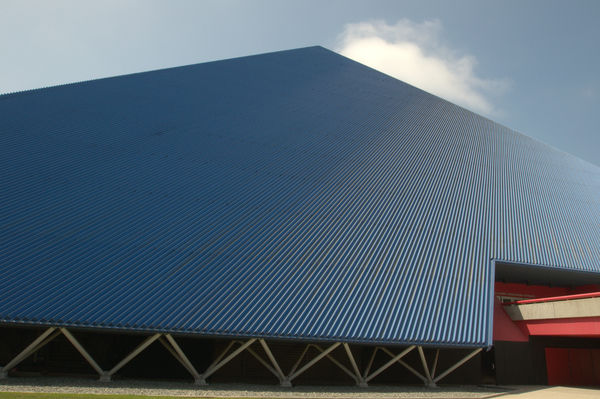What defines a fisheye lens vs a wide-angle lens?
Jul 8, 2012 13:59:23 #
In my 35-mm film days, 50-mm to 55-mm was considered a "normal" lens, and 24-mm was usually considered the cut-off between wide-angle & fisheye.
With most APS-C size sensors, 37-mm is the equivalent of 55-mm lens for film. Does that make 16-mm the new cut-off between wide & fisheye?
With most APS-C size sensors, 37-mm is the equivalent of 55-mm lens for film. Does that make 16-mm the new cut-off between wide & fisheye?
Jul 8, 2012 14:06:09 #
I always thought a fisheye did not attempt to flatten the field of a very wide angle of view, whereas as a regular wide angle lens attempts to correct barrel distortion. Is this my misconception?
Jul 8, 2012 14:29:03 #
Fisheye lenses have a field of view between 140 and 210 degrees, and make no attempt to correct the curvature.
There is a fabulous Nikkor, the 6mm f/2.8 (FX full frame,) which had, as I recall, a 210 degree field of view. It was commonly used for night meteor watching on automated systems. The entire US night sky was photographed this way, all night, for decades. If a meteor became a meteorite, it could be found by triangulation very quickly. It is also proof, though, that there are either no UFOs, or a there is a big conspiracy going on. Conspiracies are more fun.
There are 14mm rectilinear lenses (no curvature) for FX cameras, and in DX, a fisheye is going to be sub 12mm, because 12mm is only kind of wide on DX.
There is a fabulous Nikkor, the 6mm f/2.8 (FX full frame,) which had, as I recall, a 210 degree field of view. It was commonly used for night meteor watching on automated systems. The entire US night sky was photographed this way, all night, for decades. If a meteor became a meteorite, it could be found by triangulation very quickly. It is also proof, though, that there are either no UFOs, or a there is a big conspiracy going on. Conspiracies are more fun.
There are 14mm rectilinear lenses (no curvature) for FX cameras, and in DX, a fisheye is going to be sub 12mm, because 12mm is only kind of wide on DX.
Jul 8, 2012 15:59:29 #
I have to agree that the fisheye is defined by the curved distortion. Nikon's DX fisheye is 10.5mm.
Jul 9, 2012 10:33:55 #
I really don't know the answer to this question from a technical stand. But to me a fisheye was always a fully round image within the frame. Sort of like seeing the entire circle of confusion. If it is still super wide and within the frame, I've always thought it was referred to as a "rectilinear" lens.
I strongly suspect I am wrong on this...just my own verbage...I've always called a fully distorted round image lens a "fisheye" and an ultra wide lens that is as corrected as possible, yet still producing a rectangle a rectilinear.
I strongly suspect I am wrong on this...just my own verbage...I've always called a fully distorted round image lens a "fisheye" and an ultra wide lens that is as corrected as possible, yet still producing a rectangle a rectilinear.
Jul 9, 2012 11:08:12 #
Nikonian72 wrote:
In my 35-mm film days, 50-mm to 55-mm was considered a "normal" lens, and 24-mm was usually considered the cut-off between wide-angle & fisheye.
With most APS-C size sensors, 37-mm is the equivalent of 55-mm lens for film. Does that make 16-mm the new cut-off between wide & fisheye?
With most APS-C size sensors, 37-mm is the equivalent of 55-mm lens for film. Does that make 16-mm the new cut-off between wide & fisheye?
I don't think it is the MM that really matter..
Sigma Makes an 8-16 "wide angle" and then there are designated fisheyes that don't attempt to correct the distortion.
I know on my Nikon 10-24 the 10mm is getting 'fishy' and at 12mm the distortion is almost all gone..
Jul 9, 2012 16:17:56 #
Roger Hicks
Loc: Aquitaine
Curvilinear distortion.
You can make a 15mm fish-eye (180 degrees corner to corner on full format) or 15mm rectilinear (about 120 degrees corner to corner, but without straight lines bent into curves). I have both...
Cheers,
R.
You can make a 15mm fish-eye (180 degrees corner to corner on full format) or 15mm rectilinear (about 120 degrees corner to corner, but without straight lines bent into curves). I have both...
Cheers,
R.
Jul 9, 2012 16:33:19 #
Mudshark wrote:
You got that right:Sort of like seeing the entire circle of confusion. I strongly suspect I am wrong on this . . .
FAQ: Common Photographic Terms & Abbreviations
Circle of Confusion = In photography, used to determine the depth of field, the part of an image that is acceptably sharp. A standard value of CoC is often associated with each image format, but the most appropriate value depends on visual acuity, viewing conditions, and the amount of enlargement. Properly, this is the maximum permissible circle of confusion, the circle of confusion diameter limit, or the circle of confusion criterion, but is often informally called simply the circle of confusion.
Jul 9, 2012 16:48:41 #
This past weekend, I briefly played with a Tamron 10-24mm lens, which seems to cross into both categories, and I am curious as to how it would be classified.
Jul 9, 2012 17:12:06 #
Nikonian72 wrote:
This past weekend, I briefly played with a Tamron 10-24mm lens, which seems to cross into both categories, and I am curious as to how it would be classified.
O.K....I'm being a smartass (because I don't really have a clue)
but perhaps it's called a rectilinear fisheye...
Jul 9, 2012 17:16:40 #
Roger Hicks wrote:
Curvilinear distortion.
You can make a 15mm fish-eye (180 degrees corner to corner on full format) or 15mm rectilinear (about 120 degrees corner to corner, but without straight lines bent into curves). I have both...
Cheers,
R.
You can make a 15mm fish-eye (180 degrees corner to corner on full format) or 15mm rectilinear (about 120 degrees corner to corner, but without straight lines bent into curves). I have both...
Cheers,
R.
Roger, I have a Canon 14mm 1:2.8L II. I really love this lens in certain applications. But now I'm not at all sure "what it is?" I have been calling it a rectilinear...???
Jul 9, 2012 18:26:08 #
Mudshark wrote:
I think that 2% Cortisone cream treatment will clear-up your problem.I have been calling it a rectilinear...???
Jul 9, 2012 18:39:21 #
Jul 9, 2012 18:51:54 #
Nikonian72 wrote:
Mudshark wrote:
I think that 2% Cortisone cream treatment will clear-up your problem.I have been calling it a rectilinear...???
I didn't say I was itch'n to shoot anything...
Jul 9, 2012 18:55:32 #
Mudshark wrote:
Point taken.Nikonian72 wrote:
I didn't say I was itch'n to shoot anything...Mudshark wrote:
I think that 2% Cortisone cream treatment will clear-up your problem.I have been calling it a rectilinear...???
If you want to reply, then register here. Registration is free and your account is created instantly, so you can post right away.










